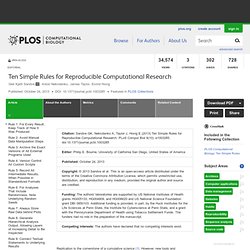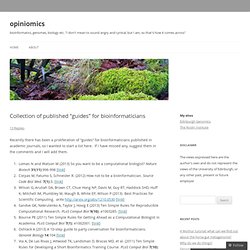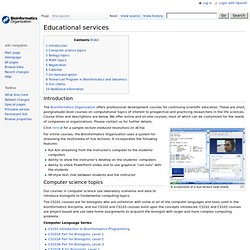

Ten Simple Rules for Reproducible Computational Research. Citation: Sandve GK, Nekrutenko A, Taylor J, Hovig E (2013) Ten Simple Rules for Reproducible Computational Research.

PLoS Comput Biol 9(10): e1003285. doi:10.1371/journal.pcbi.1003285 Editor: Philip E. Bourne, University of California San Diego, United States of America Published: October 24, 2013 Copyright: © 2013 Sandve et al. Funding: The authors' laboratories are supported by US National Institutes of Health grants HG005133, HG004909, and HG006620 and US National Science Foundation grant DBI 0850103. Competing interests: The authors have declared that no competing interests exist. Replication is the cornerstone of a cumulative science [1]. We want to emphasize that reproducibility is not only a moral responsibility with respect to the scientific field, but that a lack of reproducibility can also be a burden for you as an individual researcher. As a minimal requirement, you should at least be able to reproduce the results yourself. Rule 2: Avoid Manual Data Manipulation Steps References.
Collection of published “guides” for bioinformaticians. Recently there has been a proliferation of “guides” for bioinformaticians published in academic journals, so I wanted to start a list here.

If I have missed any, suggest them in the comments and I will add them. Loman N and Watson M (2013) So you want to be a computational biologist? Nature Biotech 31(11):996-998 [link]Corpas M, Fatumo S, Schneider R. (2012) How not to be a bioinformatician. Source Code Biol Med. 7(1):3. [link]Wilson G, Aruliah DA, Brown CT, Chue Hong NP, Davis M, Guy RT, Haddock SHD, Huff K, Mitchell IM, Plumbley M, Waugh B, White EP, WIlson P (2013) Best Practices for Scientific Computing. arXiv [link]Sandve GK, Nekrutenko A, Taylor J, Hovig E (2013) Ten Simple Rules for Reproducible Computational Research.
I am sure there are one or two more out there ;-) Like this: Like Loading... PLOS Collections : Article collections published by the Public Library of Science. Bioinformatics.ca - Canadian Bioinformatics Workshops (CBW) Video Tip of the Week: MapMi, automated mapping of microRNA loci. Bioinformatics Organization - Bioinformatics.Org. Humanizing Bioinformatics. I was invited last week to give a talk at this year's meeting of the Graduate School Structure and Function of Biological Macromolecules, Bioinformatics and Modeling (SFMBBM).

It ended up being a day with great talks, by some bright PhD students and postdocs. There were 2 keynotes (one by Prof Bert Poolman from Groningen (NL) and one by myself), and a panel discussion on what the future holds for people nearing the end of their PhDs. My talk was titled "Humanizing Bioinformatics" and received quite well (at least some people still laughed at my jokes (if you can call them that); even at the end).
I put the slides up on slideshare, but I thought I'd explain things here as well, because those slides will probably not convey the complete story. Let's ruin the plot by mentioning it here: we need data visualization to counteract the alienation that's happening between bioinformaticians and bright data miners on the one hand, and the user/clinician/biologist on the other. Yale Bioinformatics. The Elements of Bioinformatics. Educational services - Bioinformatics.Org Wiki. From Bioinformatics.Org Wiki Introduction The Bioinformatics Organization offers professional development courses for continuing scientific education.

These are short, postgraduate-level courses on computational topics of interest to prospective and practicing researchers in the life sciences. Course titles and descriptions are below. We offer online and on-site courses, most of which can be customized for the needs of companies or organizations. A screenshot of a live lecture held online Click here for a sample lecture (reduced resolution) on dChip. For online courses, the Bioinformatics Organization uses a system for streaming the multimedia of live lectures. Full A/V streaming from the instructor's computer to the students' computers Ability to show the instructor's desktop on the students' computers Ability to share PowerPoint slides and to use graphical "call-outs" with the students IM-style text chat between students and the instructor Computer science topics Machine Learning Series.
Introduction to automatic gene annotation (Cold Spring Harbor, NY, US)